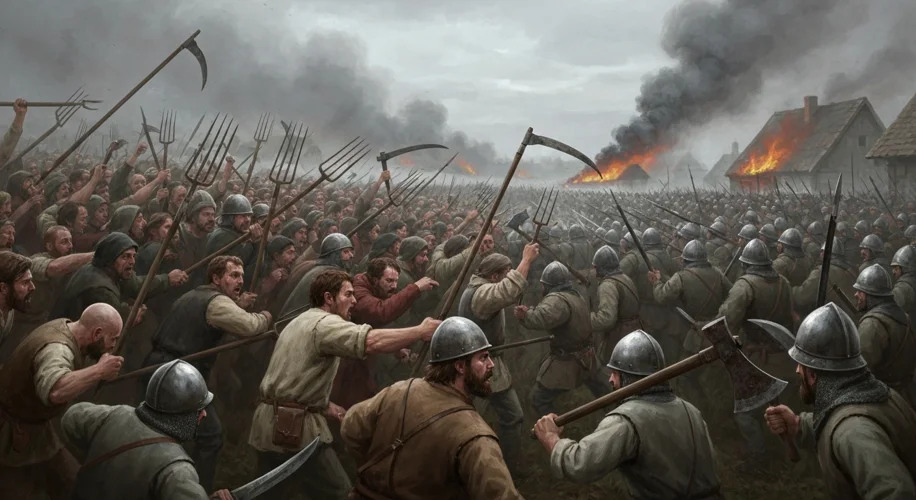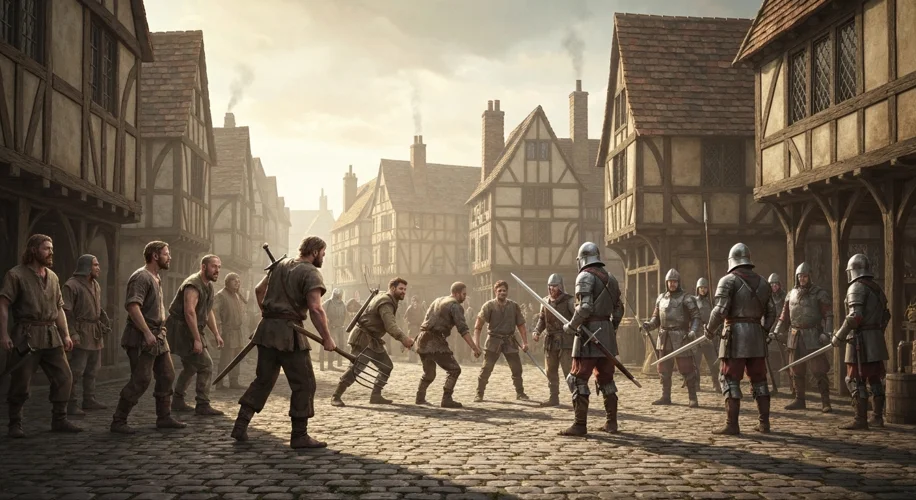The image is iconic, almost a caricature: a furious mob of peasants, their faces contorted with rage, armed with sharpened pitchforks and blazing torches, rising up against their oppressors. It conjures visions of disorganized, desperate villagers driven to a primal fury. But how accurate is this enduring depiction of medieval and early Renaissance peasant revolts? While the pitchfork certainly made its appearance, the reality of peasant weaponry and tactics was often far more nuanced and, at times, surprisingly effective.
The romanticized image of the pitchfork-wielding peasant is not entirely without foundation. For many rural folk, the pitchfork, a tool of everyday labor, was the most readily available means of defense or offense. Its sharpened tines could inflict a nasty wound, and when wielded with the weight of desperation, it was a fearsome, albeit crude, weapon. Torches, too, served a dual purpose: to sow terror and confusion, and to illuminate the path of the rebellion, often against the backdrop of burning manor houses or tax offices.
However, to limit the arsenal of rebellious peasants to just these items would be a disservice to their ingenuity and the varied nature of their uprisings. Consider the English Peasants’ Revolt of 1381. While pitchforks were undoubtedly present, the rebels, who numbered in the tens of thousands and even occupied London, also employed more organized weaponry. Many had served as soldiers in France during the Hundred Years’ War and brought back with them the skills and the tools of conflict. Swords, axes, bows and arrows, and even captured military equipment found their way into the hands of the rebels. They were not merely a rabble; they were a force that threatened the very foundations of the English monarchy.

The Jacquerie in France, which erupted in 1358, provides another compelling example. This brutal uprising saw peasants, driven to the brink by war, plague, and oppressive taxation, turn their fury upon the nobility. While early accounts focus on the horrific violence inflicted by the peasants, often using their agricultural tools like axes and sharpened stakes, the rebellion also demonstrated a degree of tactical awareness. They targeted the very symbols of feudal power: castles and the knights who inhabited them. The ferocity of their attacks, though ultimately quelled, was enough to shock the French aristocracy.
Beyond the immediate weaponry, the tactics of peasant revolts often revolved around exploiting their numbers and their intimate knowledge of the local terrain. They would frequently gather in large, often unwieldy, numbers, overwhelming their opponents through sheer force of presence. Ambushes in forests or narrow passes, the destruction of bridges to cut off enemy movements, and the seizure of strategic locations like towns and castles were common strategies. Their objectives were not always about outright military victory; often, they aimed to extract concessions, destroy symbols of authority, or simply to terrorize their overlords into submission.
The underlying causes of these revolts were as varied as the weapons they employed. Economic hardship, burdensome taxation (often exacerbated by the costs of war), social inequality, and the erosion of traditional rights were common grievances. The Black Death, which swept through Europe in the mid-14th century, had a profound demographic impact, leading to labor shortages and a subsequent increase in peasant bargaining power. When lords attempted to reassert control or impose harsher conditions, the stage was often set for rebellion.
In conclusion, the image of peasants armed solely with pitchforks and torches, while evocative, is an oversimplification. While these tools were indeed part of the peasant arsenal, many revolts involved a more diverse array of weaponry, including stolen or acquired arms, and demonstrated a capacity for organized action and strategic thinking. The pitchfork-wielding peasant was a symbol of desperate resistance, but the reality of peasant rebellions was a complex tapestry of social, economic, and military factors, often far more formidable than the iconic image suggests. These uprisings, though frequently suppressed, left an indelible mark on the history of Europe, shaping the relationship between the rulers and the ruled for centuries to come.

